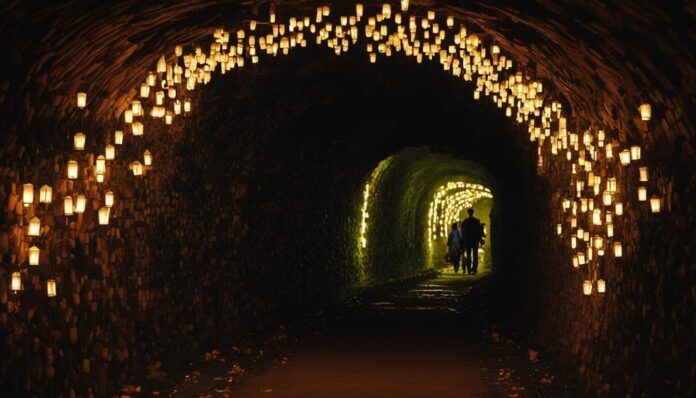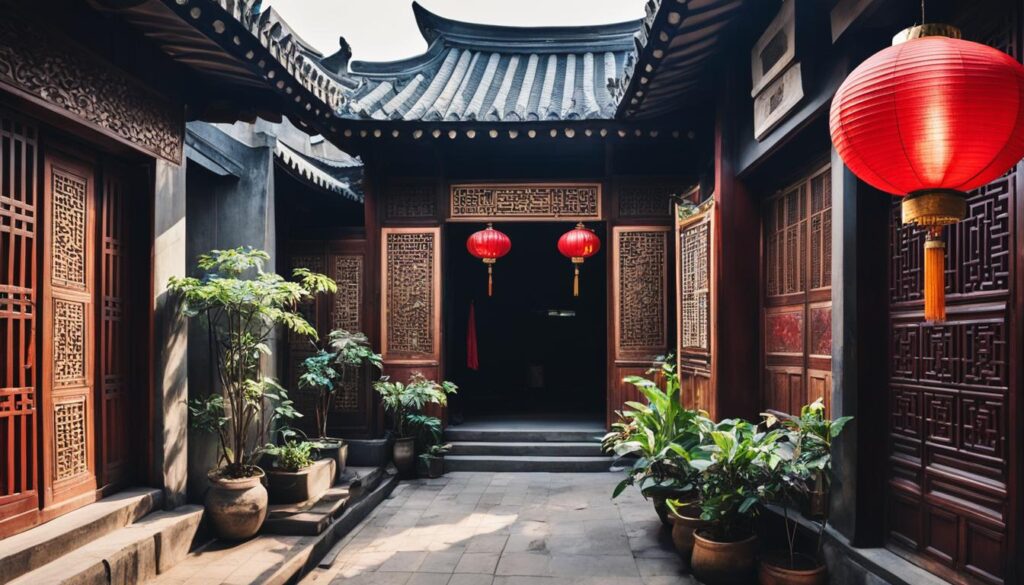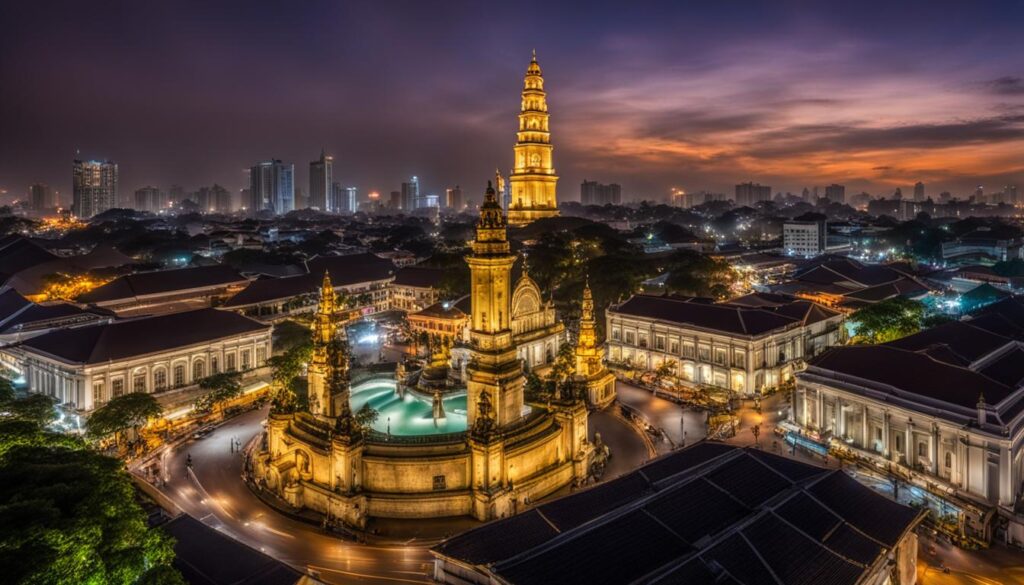When traveling to Jakarta, exploring the city’s historical places is a must. While the National Museum offers a glimpse into Indonesia’s past, there are hidden gems waiting to be discovered if you venture beyond its walls. These offbeat attractions showcase Jakarta’s rich history and offer an authentic and immersive experience unlike any other.
From ancient roots to Dutch colonial architecture, Jakarta’s history is as diverse as it is fascinating. By uncovering the city’s lesser-known historical landmarks, you can gain insights into its culture and heritage that go beyond what you’ll find in guidebooks.
If you’re looking for something unique and off the beaten path, exploring Jakarta’s hidden historical gems is a great way to experience the city’s rich culture and heritage. Get ready to discover the historical sites and offbeat attractions that offer a glimpse into Jakarta’s unique past.
Uncovering Jakarta’s Forgotten History
While the National Museum may be the most popular historical attraction in Jakarta, the city is home to many other lesser-known historical sites that hold great cultural significance. These sites, often forgotten, have played a significant role in shaping the city into what it is today.
Some of the historical landmarks that are often overlooked include the Maritime Museum, which showcases Jakarta’s seafaring past; and the Chicken Market Bridge, a relic of Dutch colonialism. Additionally, visitors can explore the Temple of the Thousand Pillars, an ancient Buddhist temple dating back to the 9th century; and the Setu Babakan Traditional Betawi Village, which offers a glimpse into the traditional Betawi lifestyle.
To truly uncover Jakarta’s forgotten history, it’s essential to visit these hidden gems and explore the offbeat attractions that showcase the city’s heritage. Take the time to delve into Jakarta’s lesser-known historical sites and discover the cultural significance that they hold.
Must-Visit Historical Sites Near the National Museum
If you’re interested in delving deeper into Jakarta’s history, don’t miss out on the must-visit historical sites situated near the National Museum.
| Historic Place | Description |
|---|---|
| Monas | This iconic monument is a must-see attraction in Jakarta and represents the country’s struggle for independence. |
| Fatahillah Square | This public square was the site of important historical events during Indonesia’s colonial period and now hosts several museums. |
| Gedung Proklamasi | Located just a short distance from the National Museum, this building is where Indonesia’s founding fathers declared its independence in 1945. |
In addition to these top sights, there are many other historical sites worth visiting in the area. You can explore the Jakarta History Museum, located inside the old city hall building, or tour the Istiqlal Mosque, the largest mosque in Southeast Asia.
With so many fascinating historical places near the National Museum, take the time to uncover Jakarta’s rich past.
Unearthing Undiscovered Historical Sites
When visiting Jakarta, don’t miss the chance to discover the city’s undiscovered historical sites for a unique and authentic experience. These hidden gems are yet to be explored by many tourists, making them perfect for historical tourism in Jakarta.
One such site is the Kota Tua area, also known as Old Town Jakarta. This historic neighborhood features Dutch colonial architecture, museums, and street food stalls that offer a taste of local culture. A stroll through the narrow streets will transport you back in time to the city’s early days.
The Kota Tua area is like traveling through time. Walking among the old buildings gives you a sense of how Jakarta must have looked and felt like in the past.
Another hidden gem is the Satria Mandala Museum, dedicated to the history of the Indonesian Armed Forces. Here, you can find an impressive collection of military vehicles, weapons, and uniforms, along with exhibits detailing Indonesia’s fight for freedom.
Exploring these undiscovered historical sites in Jakarta will broaden your knowledge of the city’s rich history and cultural heritage. This will offer you a deeper understanding of Jakarta’s past, making your trip to the city even more memorable.
Exploring Dutch Colonial Architecture in Jakarta
If you’re interested in architectural history, Jakarta has many hidden gems that showcase the unique Dutch colonial style. In the early 17th century, the Dutch established a trading post in Jakarta and went on to colonize the Indonesian archipelago. Their influence can be seen in the city’s architecture, which blends European and local styles.
One of the most iconic examples of Dutch colonial architecture is the Gereja Sion church. Built in 1695, it is the oldest surviving church in Jakarta and has a distinctive bell tower and octagonal base. Another must-visit spot is the Graha Maria Annai Velangkanni, a Catholic shrine that features a fusion of European and Indian styles.
If you’re interested in learning more about Dutch colonial architecture, head to the Historic Museum of Jakarta where you can explore exhibitions on the city’s history and colonial past. You can also visit the Toko Merah, a well-preserved Dutch colonial mansion that showcases the opulent lifestyle of the city’s colonial rulers.
Must-Visit Historical Sites Featuring Dutch Colonial Architecture in Jakarta
| Site | Description |
|---|---|
| Gereja Sion | The oldest surviving church in Jakarta, featuring a unique bell tower and octagonal base. |
| Graha Maria Annai Velangkanni | A Catholic shrine boasting a fusion of European and Indian styles. |
| Historic Museum of Jakarta | An informative museum where visitors can learn about the city’s history and colonial past. |
| Toko Merah | A well-preserved Dutch colonial mansion that offers a glimpse into the opulent lifestyle of colonial rulers. |
If you’re looking for a unique and authentic cultural experience in Jakarta, be sure to explore the city’s Dutch colonial architecture. From churches to museums, there is much to discover beyond the usual tourist hotspots.
Tracing Jakarta’s Ancient Roots
Experience the ancient heritage of Jakarta by visiting historical sites that date back to the city’s earliest civilizations. These hidden gems offer insights into the cultural significance of Jakarta’s rich history.
Kota Tua
Kota Tua, also known as Old Batavia, is a colonial-era district that showcases the city’s Dutch and Chinese heritage. Visitors can explore the historic architecture, museums, and attractions, including the Jakarta History Museum, the Wayang Museum, and Café Batavia.
Candi Borobudur
Candi Borobudur is a UNESCO World Heritage Site located near Yogyakarta in Central Java, but it’s still worth a visit for its cultural significance. This ancient temple is the world’s largest Buddhist temple and dates back to the 9th century. Visitors can explore the intricate carvings and marvel at the architecture that survived centuries of neglect and natural disasters.
Taman Mini Indonesia Indah
Taman Mini Indonesia Indah, also known as Beautiful Indonesia Miniature Park, is a cultural theme park that offers a journey through Indonesia’s history and regions. Visitors can explore the traditional houses, arts and crafts workshops, and performances that showcase the cultural diversity of Indonesia.
Exploring the Chinese Influence in Jakarta’s History
If you want to learn more about the Chinese influence on Jakarta’s history, there are several historical places worth visiting.
Glodok
Located in West Jakarta, Glodok is one of Jakarta’s oldest Chinese communities and is home to many shops and restaurants that offer a glimpse into the Chinese culture and history. Some of the must-visit places in Glodok include the Vihara Dharma Bhakti temple and the Petak Sembilan traditional market.
Onrust Island
Onrust Island, located in the Jakarta Bay, is a small island that played an important role in Jakarta’s maritime history. The island was once a center of trade and commerce and was home to many Chinese merchants who helped shape the city’s economy. Today, the island is home to several historical landmarks, including the Dutch cemetery and a fort that was used during the colonial era.
| Historical place | Description |
|---|---|
| Vihara Dharma Bhakti temple | A Chinese temple located in the heart of Glodok that dates back to the 17th century. |
| Petak Sembilan traditional market | A bustling market that offers a glimpse into the daily lives of Jakarta’s Chinese community. |
| Dutch cemetery | A cemetery that dates back to the colonial era and is home to the graves of many Dutch and Chinese |
| Fort Onrust | A fort that was built during the colonial era to protect the Dutch East India Company’s trade interests in the region. |
These hidden gems offer unique insights into Jakarta’s rich cultural heritage and are a must-visit for anyone interested in exploring the city’s history beyond the National Museum.
Reliving Jakarta’s Revolutionary Era
Step back in time and experience Jakarta’s revolutionary era by visiting historical sites that played a crucial part during this significant period in Indonesian history.
The National Monument, or Monas, commemorates Indonesia’s struggle for independence and offers stunning panoramic views of the city. You can also explore the museum located beneath the monument that showcases Indonesia’s history and struggle for freedom.
Another must-visit site is the former Dutch colonial Batavia, now known as Kota Tua. This area features well-preserved colonial buildings and museums that reflect Jakarta’s past. You can explore the Jakarta History Museum, or Museum Fatahillah, which exhibits the city’s history under Dutch colonization.
“The National Monument, or Monas, commemorates Indonesia’s struggle for independence and offers stunning panoramic views of the city.”
Don’t miss the Gedung Joang 45, a museum dedicated to the country’s struggle for independence. The museum features photographs, documents, and other artifacts that provide insight into the nation’s independence movement. You can also visit the Taman Proklamasi, where Indonesia’s first president proclaimed the country’s independence from Dutch colonial rule.
These historical sites in Jakarta offer a glimpse into the city’s past and the struggle for independence that shaped Indonesia as we know it. Don’t forget to put on your exploring shoes and uncover the hidden gems among Jakarta’s historical places.
Discovering Jakarta’s Maritime Heritage
If you’re a history buff, Jakarta’s maritime heritage sites are bound to intrigue you. The city has a rich seafaring past, which is evident in its historical places and hidden gems. These sites offer a glimpse into Jakarta’s connection with the sea, its trade routes, and the impact of the ocean on the city’s development.
One of the must-see historical places in Jakarta is the Old Harbour (Sunda Kelapa), located in the northern part of the city. This bustling port has been in operation since the 13th century and played a vital role in Jakarta’s early development. Visitors can witness traditional wooden schooners (known as Pinisi) being loaded with goods as they sail on to other parts of Indonesia.
| Name of the Historical Place | Description |
|---|---|
| Maritime Museum | Located in the former Dutch East India Company warehouse, this museum provides an overview of Jakarta’s maritime history, including its interactions with other Asian countries. |
| Fatahillah Square | This atmospheric square was once the administrative center of the Dutch East India Company. It features the Jakarta History Museum, which covers the city’s history from the pre-colonial era to the present day. |
| Ancol Beach City | Located on the outskirts of Jakarta, this beach city is popular with tourists and offers a range of activities, including water sports, a theme park, and art markets. Visitors can explore the Seaworld aquarium, which features a range of marine life found in Indonesia’s waters. |
Another hidden gem that reflects Jakarta’s maritime heritage is the fishing village of Muara Angke. This traditional village is located in the north of Jakarta and offers visitors a glimpse of daily life in a fishing community. Those looking for an immersive experience can sign up for a boat tour with local fishermen.
Finally, if you want to explore Jakarta’s seafaring past in a more leisurely manner, head to the marina in Ancol. This location offers boat rides that provide a panoramic view of Jakarta’s coastline and the surrounding islands.
Uncommon Museums and Galleries in Jakarta
If you’re interested in Jakarta’s history and culture, there are plenty of museums and galleries to explore. While some are well-known, others are hidden gems that offer unique insights into the city’s past. Here are some of the uncommon museums and galleries in Jakarta that are worth a visit:
Museum Bahari
Located in the historic Sunda Kelapa Harbour, the Museum Bahari (Maritime Museum) showcases Jakarta’s maritime history and culture. The museum features a collection of traditional boats, fishing equipment, and other historical artifacts related to the city’s seafaring past. A visit to this unique museum provides a fascinating glimpse into Jakarta’s maritime heritage.
Museum Taman Prasasti
If you’re interested in Jakarta’s colonial past, head to the Museum Taman Prasasti (Funeral Museum). The museum was originally a cemetery during the Dutch colonial era and now houses tombs of famous figures from Jakarta’s history. It also features a collection of colonial-era headstones and historical artifacts related to death and mourning practices in Jakarta. A visit to this museum is a surreal and thought-provoking experience.
Galeri Soemardja
For art lovers, the Galeri Soemardja in Jakarta offers a unique cultural experience. This gallery features contemporary works from emerging Indonesian artists and showcases a variety of mediums, including paintings, sculptures, and installations. The gallery’s focus on up-and-coming artists makes it a great place to discover new talents and experience the pulse of the city’s art scene.
Museum Sumpah Pemuda
The Museum Sumpah Pemuda (Youth Pledge Museum) offers visitors a glimpse into an important moment in Jakarta’s history. The museum commemorates the Youth Pledge of 1928, which was a pivotal moment in the city’s struggle for independence. The museum features interactive exhibits that allow visitors to learn more about this historic event and the people who played a role in it.
Whether you’re interested in maritime history, colonial-era tombs, contemporary art, or key moments in Jakarta’s history, these uncommon museums and galleries in Jakarta offer a different perspective on the city’s rich cultural heritage.
Immersive Experiences at Jakarta’s Historical Sites
When you visit historical places in Jakarta, you don’t have to settle for just admiring the architecture and artifacts. Many hidden gems offer immersive experiences to bring the city’s history to life. Here are some you don’t want to miss:
1. Fatahillah Square
Located in the heart of Old Batavia, Fatahillah Square is the perfect starting point for exploring Jakarta’s history. Visitors can take guided tours of the Jakarta History Museum, which is housed in the former City Hall building and showcases the city’s evolution through various exhibits. The square also offers cultural and musical performances, transporting you back to the colonial era.
2. Wayang Museum
The Wayang Museum is a hidden gem that showcases the art of Indonesian puppetry. Visitors can watch live wayang shows or take part in workshops to learn how to make their own puppets. There are also interactive exhibits that allow you to interact with shadow puppets and learn the stories behind them, making for an engaging and educational experience.
3. Taman Mini Indonesia Indah
Taman Mini Indonesia Indah is a unique cultural park that showcases the diversity of Indonesia’s culture. Visitors can explore traditional houses and learn about the different regions of Indonesia. The park also offers cultural performances, such as traditional dances and music, allowing you to experience Indonesia’s rich heritage firsthand.
These immersive experiences are just a few examples of the hidden gems waiting to be discovered at Jakarta’s historical sites. With so much to explore, there’s no better time to step back in time and discover the city’s fascinating history.
Conclusion
Congratulations on exploring Jakarta’s unique historical sites beyond the National Museum! By uncovering the hidden gems and offbeat attractions, you’ve gained a deeper understanding of the city’s rich history and cultural significance.
From discovering the forgotten historical landmarks to tracing Jakarta’s ancient roots, there’s so much to explore in this vibrant capital. You’ve learned about the must-visit historical sites near the National Museum and the undiscovered historical sites waiting to be explored.
You’ve also delved into Jakarta’s Dutch colonial architecture, Chinese influence, revolutionary era, and maritime heritage. And let’s not forget the uncommon museums and galleries that offer immersive experiences to bring the city’s history to life.
We hope you continue to explore and uncover the hidden history of Jakarta, discovering new and fascinating stories along the way. Happy travels!
















































